High-Frequency and High-Power Performance of n-Type GaN Epilayers with Low Electron Density Grown on Native Substrate
Abstract
:1. Introduction
2. Experimental Details
3. Results and Discussion
4. Conclusions
Author Contributions
Funding
Institutional Review Board Statement
Informed Consent Statement
Data Availability Statement
Conflicts of Interest
References
- Arakawa, Y.; Ueno, K.; Imabeppu, H.; Kobayashi, A.; Ohta, J.; Fujioka, H. Electrical properties of Si-doped GaN prepared using pulsed sputtering. Appl. Phys. Lett. 2017, 110, 042103. [Google Scholar] [CrossRef]
- Kyle, E.C.H.; Kaun, S.W.; Burke, P.G.; Wu, F.; Wu, Y.R.; Speck, J.S. High-electron-mobility GaN grown on free-standing GaN templates by ammonia-based molecular beam epitaxy. J. Appl. Phys. 2014, 115, 193702. [Google Scholar] [CrossRef]
- Heying, B.; Smorchkova, I.; Poblenz, C.; Elsass, C.; Fini, P.; Den Baars, S.; Mishra, U.; Speck, J.S. Optimization of the surface morphologies and electron mobilities in GaN grown by plasma-assisted molecular beam epitaxy. Appl. Phys. Lett. 2000, 77, 2885–2887. [Google Scholar] [CrossRef]
- Cao, Y.; Chu, R.; Li, R.; Chen, M.; Chang, R.; Hughes, B. High-voltage vertical GaN Schottky diode enabled by low-carbon metal-organic chemical vapor deposition growth. Appl. Phys. Lett. 2016, 108, 062103. [Google Scholar] [CrossRef]
- Kizilyalli, I.C.; Edwards, A.P.; Aktas, O.; Prunty, T.; Bour, D. Vertical power p-n diodes based on bulk GaN. IEEE Trans. Electron Devices 2015, 62, 414–422. [Google Scholar] [CrossRef]
- Kruszewski, P.; Prystawko, P.; Kasalynas, I.; Nowakowska-Siwinska, A.; Krysko, M.; Plesiewicz, J.; Smalc-Koziorowska, J.; Dwilinski, R.; Zajac, M.; Kucharski, R.; et al. AlGaN/GaN HEMT structures on ammono bulk GaN substrate. Semicond. Sci. Technol. 2014, 29, 075004. [Google Scholar] [CrossRef]
- Sai, P.; Jorudas, J.; Dub, M.; Sakowicz, M.; Jakštas, V.; But, D.B.; Prystawko, P.; Cywinski, G.; Kašalynas, I.; Knap, W.; et al. Low frequency noise and trap density in GaN/AlGaN field effect transistors. Appl. Phys. Lett. 2019, 115, 183501. [Google Scholar] [CrossRef]
- Dannecker, K.; Baringhaus, J. Fully vertical gallium nitride trench MOSFETs fabricated with metal-free gate first process. J. Vac. Sci. Technol. B Nanotechnol. Microelectron. Mater. Processing Meas. Phenom. 2021, 39, 032204. [Google Scholar] [CrossRef]
- Tanaka, N.; Hasegawa, K.; Yasunishi, K.; Murakami, N.; Oka, T. 50 A vertical GaN Schottky barrier diode on a free-standing GaN substrate with blocking voltage of 790 V. Appl. Phys. Express 2015, 8, 071001. [Google Scholar] [CrossRef]
- Kruszewski, P.; Prystawko, P.; Grabowski, M.; Sochacki, T.; Sidor, A.; Bockowski, M.; Jasinski, J.; Lukasiak, L.; Kisiel, R.; Leszczynski, M. Electrical properties of vertical GaN Schottky diodes on Ammono-GaN substrate. Mater. Sci. Semicond. Process. 2019, 96, 132–136. [Google Scholar] [CrossRef]
- Hu, Z.; Nomoto, K.; Song, B.; Zhu, M.; Qi, M.; Pan, M.; Gao, X.; Protasenko, V.; Jena, D.; Xing, H.G. Near unity ideality factor and Shockley-Read-Hall lifetime in GaN-on-GaN p-n diodes with avalanche breakdown. Appl. Phys. Lett. 2015, 107, 243501. [Google Scholar] [CrossRef] [Green Version]
- Ueno, K.; Kobayashi, A.; Fujioka, H. Characteristics of unintentionally doped and lightly Si-doped GaN prepared via pulsed sputtering. AIP Adv. 2019, 9, 075123. [Google Scholar] [CrossRef] [Green Version]
- Koblmüller, G.; Wu, F.; Mates, T.; Speck, J.S.; Fernández-Garrido, S.; Calleja, E. High electron mobility GaN grown under N-rich conditions by plasma-assisted molecular beam epitaxy. Appl. Phys. Lett. 2007, 91, 221905. [Google Scholar] [CrossRef]
- Sawada, N.; Narita, T.; Kanechika, M.; Uesugi, T.; Kachi, T.; Horita, M.; Kimoto, T.; Suda, J. Sources of carrier compensation in metalorganic vapor phase epitaxy-grown homoepitaxial n-type GaN layers with various doping concentrations. Appl. Phys. Express 2018, 11, 041001. [Google Scholar] [CrossRef]
- Zajac, M.; Kucharski, R.; Grabianska, K.; Gwardys-Bak, A.; Puchalski, A.; Wasik, D.; Litwin-Staszewska, E.; Piotrzkowski, R.; Domagala, J.; Bockowski, M. Basic ammonothermal growth of Gallium Nitride–State of the art, challenges, perspectives. Prog. Cryst. Growth Charact. Mater. 2018, 64, 63–74. [Google Scholar] [CrossRef]
- Shalygin, V.A.; Vorobjev, L.E.; Firsov, D.A.; Panevin, V.Y.; Sofronov, A.N.; Melentyev, G.A.; Antonov, A.V.; Gavrilenko, V.I.; Andrianov, A.V.; Zakharyin, A.O.; et al. Impurity breakdown and terahertz luminescence in n-GaN epilayers under external electric field. J. Appl. Phys. 2009, 106, 123523. [Google Scholar] [CrossRef] [Green Version]
- Grigelionis, I.; Jakštas, V.; Janonis, V.; Kašalynas, I.; Prystawko, P.; Kruszewski, P.; Leszczyński, M. Terahertz Electroluminescence of Shallow Impurities in AlGaN/GaN Heterostructures at Temperatures above 80 K. Phys. Status Solidi 2018, 255, 1700421. [Google Scholar] [CrossRef]
- Moore, W.J.; Freitas, J.A.; Braga, G.C.B.; Molnar, R.J.; Lee, S.K.; Lee, K.Y.; Song, I.J. Identification of Si and O donors in hydride-vapor-phase epitaxial GaN. Appl. Phys. Lett. 2001, 79, 2570–2572. [Google Scholar] [CrossRef]
- Van de Walle, C.G. Effects of impurities on the lattice parameters of GaN. Phys. Rev. B 2003, 68, 165209. [Google Scholar] [CrossRef] [Green Version]
- Dos Santos, R.B.; Rivelino, R.; De Brito Mota, F.; Gueorguiev, G.K.; Kakanakova-Georgieva, A. Dopant species with Al–Si and N–Si bonding in the MOCVD of AlN implementing trimethylaluminum, ammonia and silane. J. Phys. D Appl. Phys. 2015, 48, 295104. [Google Scholar] [CrossRef]
- Kakanakova-Georgieva, A.; Gueorguiev, G.K.; Yakimova, R.; Janzén, E. Effect of impurity incorporation on crystallization in AlN sublimation epitaxy. J. Appl. Phys. 2004, 96, 5293–5297. [Google Scholar] [CrossRef]
- Rosa, A.L.; Neugebauer, J.; Northrup, J.E.; Lee, C.D.; Feenstra, R.M. Adsorption and incorporation of silicon at GaN(0001) surfaces. Appl. Phys. Lett. 2002, 80, 2008–2010. [Google Scholar] [CrossRef]
- Schroder, D.K. Contact Resistance and Schottky Barriers. In Semiconductor Material and Device Characterization; JOHN WILEY & SONS LTD: Hoboken, NJ, USA, 2006; pp. 127–184. [Google Scholar]
- Adamov, R.B.; Pashnev, D.; Shalygin, V.A.; Moldavskaya, M.D.; Vinnichenko, M.Y.; Janonis, V.; Jorudas, J.; Tumėnas, S.; Prystawko, P.; Krysko, M.; et al. Optical Performance of Two Dimensional Electron Gas and GaN:C Buffer Layers in AlGaN/AlN/GaN Heterostructures on SiC Substrate. Appl. Sci. 2021, 11, 6053. [Google Scholar] [CrossRef]
- Katsidis, C.C.; Siapkas, D.I. General transfer-matrix method for optical multilayer systems with coherent, partially coherent, and incoherent interference. Appl. Opt. 2002, 41, 3978–3987. [Google Scholar] [CrossRef] [PubMed]
- Jorudas, J.; Šimukovič, A.; Dub, M.; Sakowicz, M.; Prystawko, P.; Indrišiūnas, S.; Kovalevskij, V.; Rumyantsev, S.; Knap, W.; Kašalynas, I. Algan/gan on sic devices without a gan buffer layer: Electrical and noise characteristics. Micromachines 2020, 11, 1131. [Google Scholar] [CrossRef] [PubMed]
- Barker, J.M.; Akis, R.; Thornton, T.J.; Ferry, D.K.; Goodnick, S.M. High field transport studies of GaN. Phys. Status Solidi Appl. Res. 2002, 190, 263–270. [Google Scholar] [CrossRef]
- Bougrov, V.; Levinshtein, M.; Rumyantsev, S.L.; Zubrilov, A. Gallium Nitride. In Properties of Advanced Semiconductor Materials: GaN, AIN, InN, BN, SiC, SiGe; JOHN WILEY & SONS LTD: Hoboken, NJ, USA, 2001; pp. 1–30. [Google Scholar]
- Shalygin, V.A.; Vorobjev, L.E.; Firsov, D.A.; Sofronov, A.N.; Melentyev, G.A.; Lundin, W.V.; Nikolaev, A.E.; Sakharov, A.V.; Tsatsulnikov, A.F. Blackbody-like emission of terahertz radiation from AlGaN/GaN heterostructure under electron heating in lateral electric field. J. Appl. Phys. 2011, 109, 073108. [Google Scholar] [CrossRef]
- Liberis, J.; Ramonas, M.; Kiprijanovic, O.; Matulionis, A.; Goel, N.; Simon, J.; Wang, K.; Xing, H.; Jena, D. Hot phonons in Si-doped GaN. Appl. Phys. Lett. 2006, 89, 202117. [Google Scholar] [CrossRef]
- Zimmermann, T.; Deen, D.; Cao, Y.; Simon, J.; Fay, P.; Jena, D.; Xing, H.G. AlN/GaN insulated-gate HEMTs with 2.3 A/mm output current and 480 mS/mm transconductance. IEEE Electron Device Lett. 2008, 29, 661–664. [Google Scholar] [CrossRef]
- Chini, A.; Coffie, R.; Meneghesso, G.; Zanoni, E.; Buttari, D.; Heikman, S.; Keller, S.; Mishra, U.K. 2.1 A/mm current density AlGaN/GaN HEMT. Electron. Lett. 2003, 39, 625–626. [Google Scholar] [CrossRef]
- Husna Hamza, K.; Nirmal, D.; Augustine Fletcher, A.S.; Arivazhagan, L.; Ajayan, J.; Natarajan, R. Highly scaled graded channel GaN HEMT with peak drain current of 2.48 A/mm. AEU Int. J. Electron. Commun. 2021, 136, 153774. [Google Scholar] [CrossRef]
- Yang, J.; Brown, G.J.; Dutta, M.; Stroscio, M.A. Photon absorption in the Restrahlen band of thin films of GaN and AlN: Two phonon effects. J. Appl. Phys. 2005, 98, 43517. [Google Scholar] [CrossRef]
- Kucharski, R.; Janicki, Ł.; Zajac, M.; Welna, M.; Motyka, M.; Skierbiszewski, C.; Kudrawiec, R. Transparency of semi-insulating, n-type, and p-type ammonothermal GaN substrates in the near-infrared, mid-infrared, and THz spectral range. Crystals 2017, 7, 187. [Google Scholar] [CrossRef] [Green Version]
- Janonis, V.; Tumėnas, S.; Prystawko, P.; Kacperski, J.; Kašalynas, I. Investigation of n-type gallium nitride grating for applications in coherent thermal sources. Appl. Phys. Lett. 2020, 116, 112103. [Google Scholar] [CrossRef]
- Siegle, H.; Kaczmarczyk, G.; Filippidis, L.; Litvinchuk, A.; Hoffmann, A.; Thomsen, C. Zone-boundary phonons in hexagonal and cubic GaN. Phys. Rev. B 1997, 55, 7000–7004. [Google Scholar] [CrossRef]
- Kasic, A.; Schubert, M.; Einfeldt, S.; Hommel, D.; Tiwald, T.E. Free-carrier and phonon properties of n- and p-type hexagonal GaN films measured by infrared ellipsometry. Phys. Rev. B 2000, 62, 7365–7377. [Google Scholar] [CrossRef]
- Khorasani, S.; Rashidian, B. Modified transfer matrix method for conducting interfaces. J. Opt. A Pure Appl. Opt. 2002, 4, 251–256. [Google Scholar] [CrossRef]
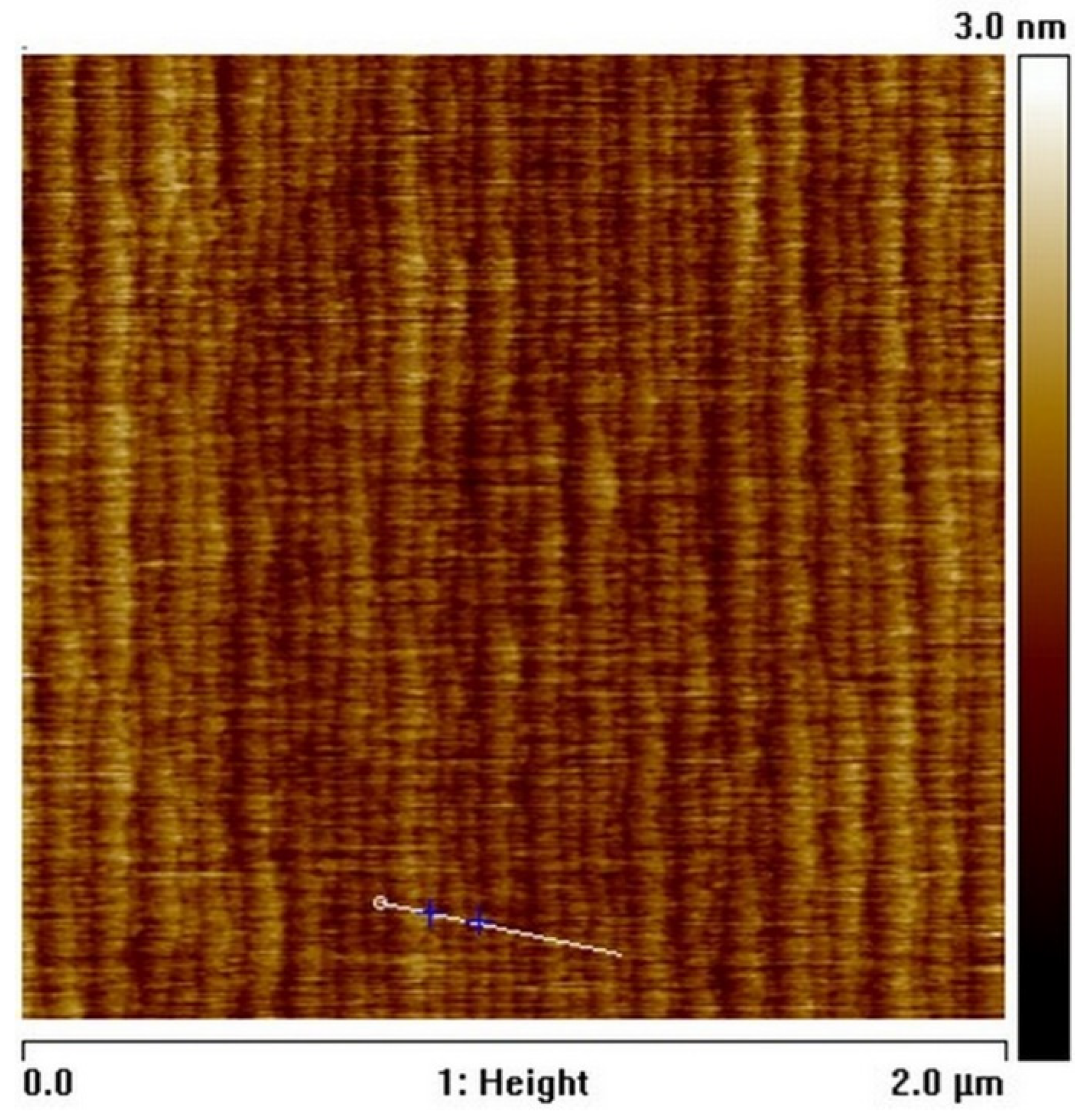
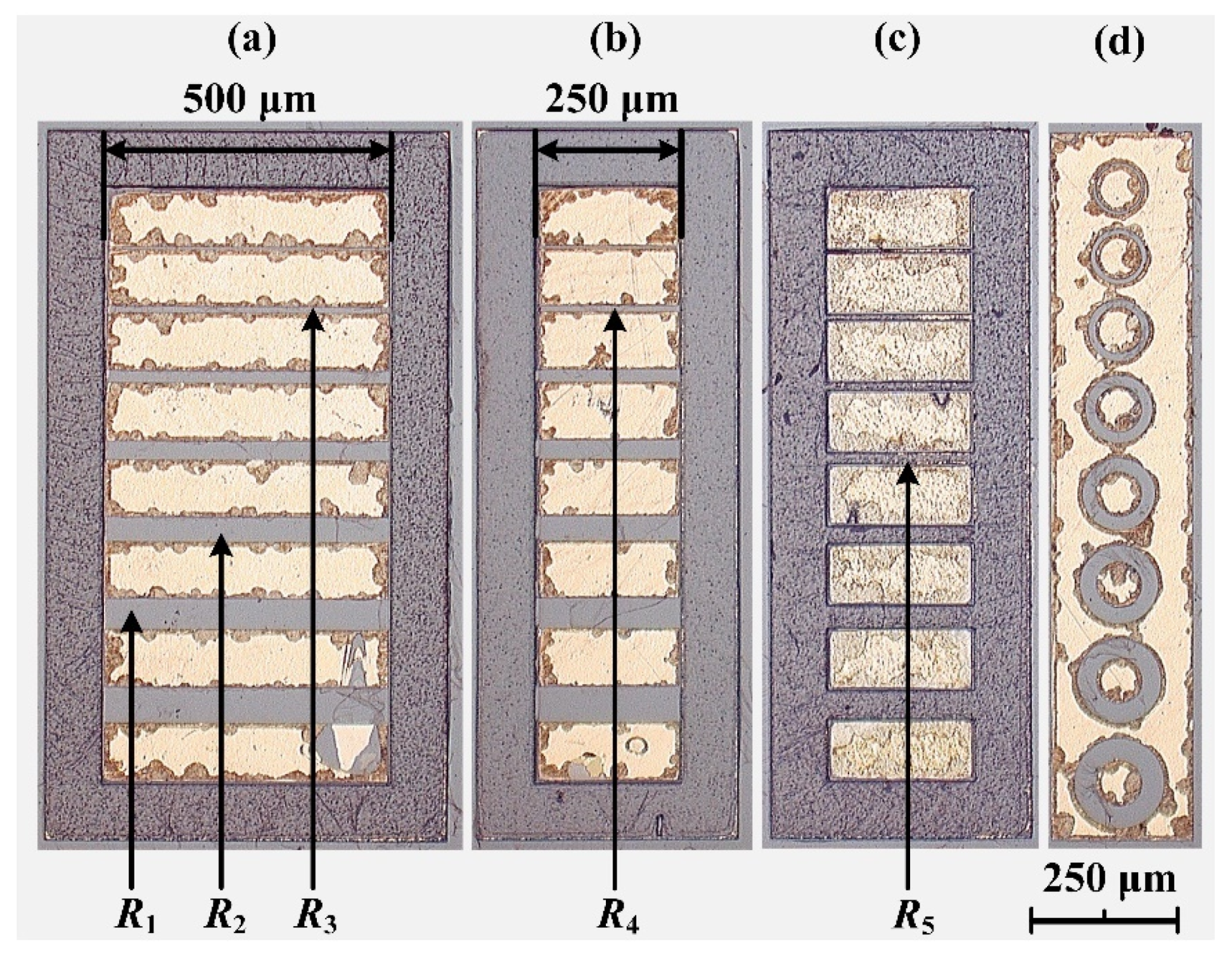
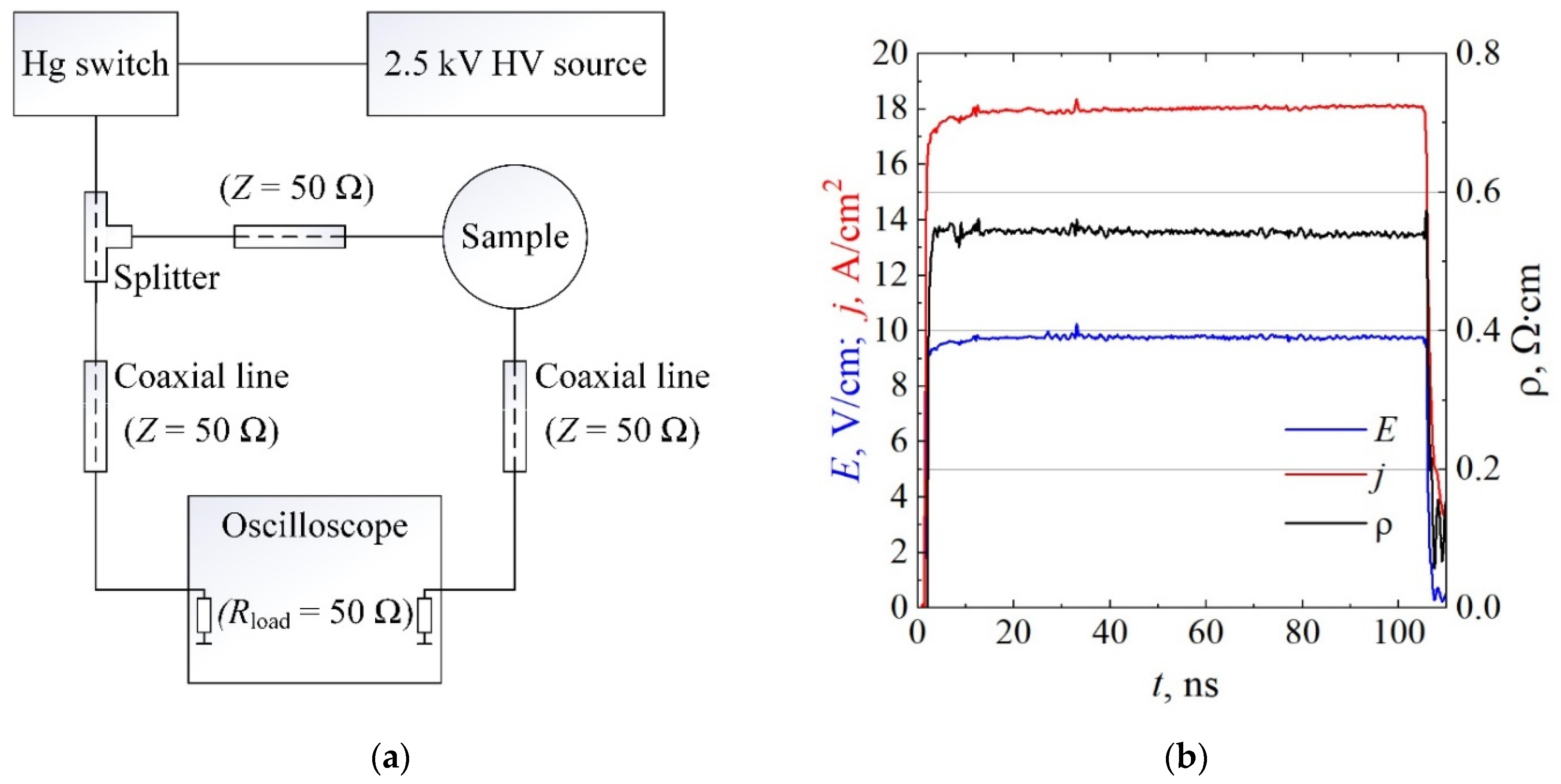
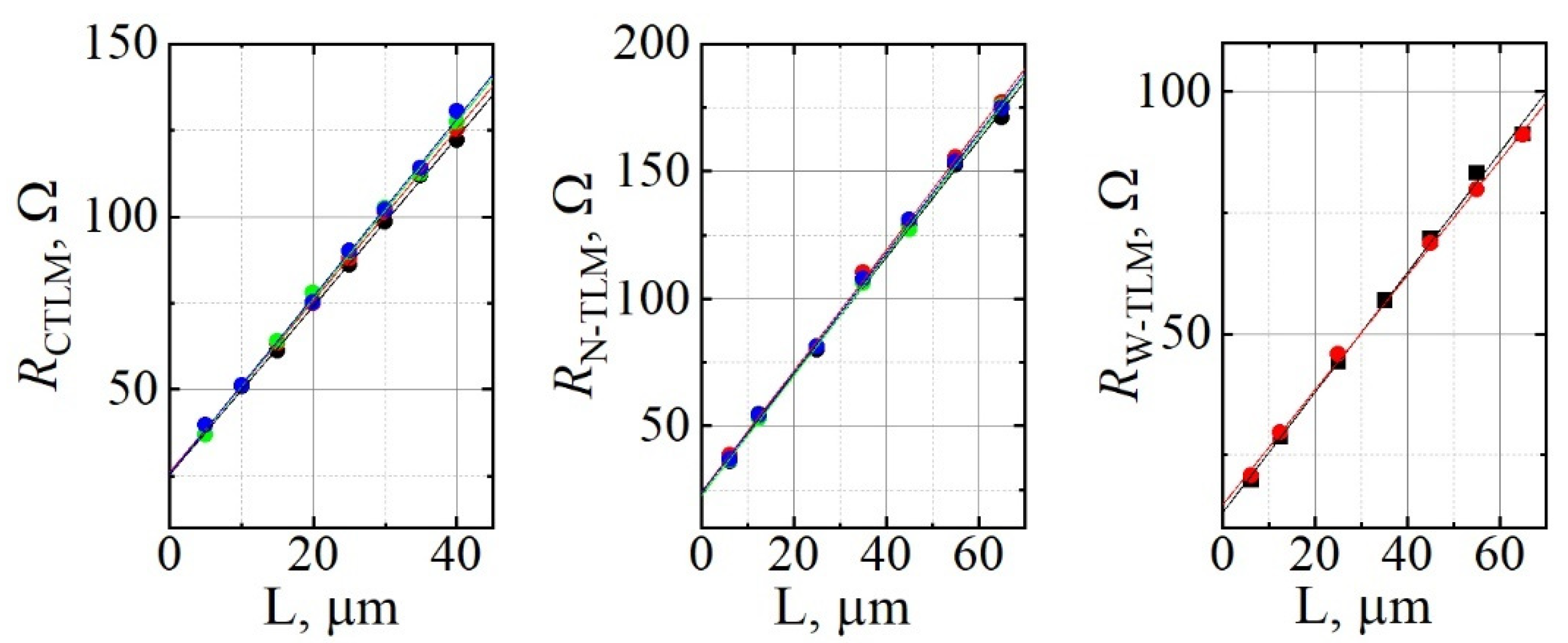
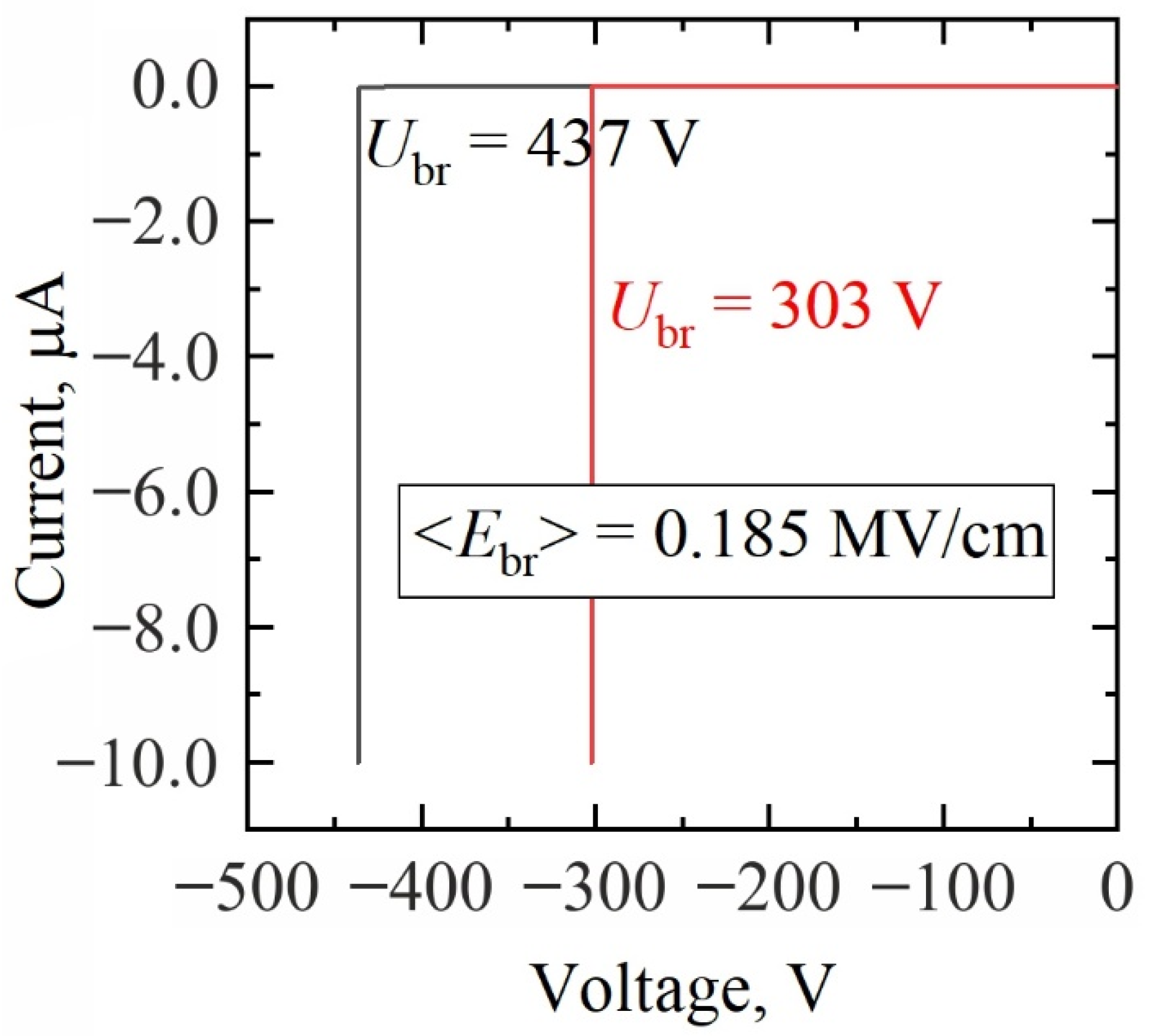
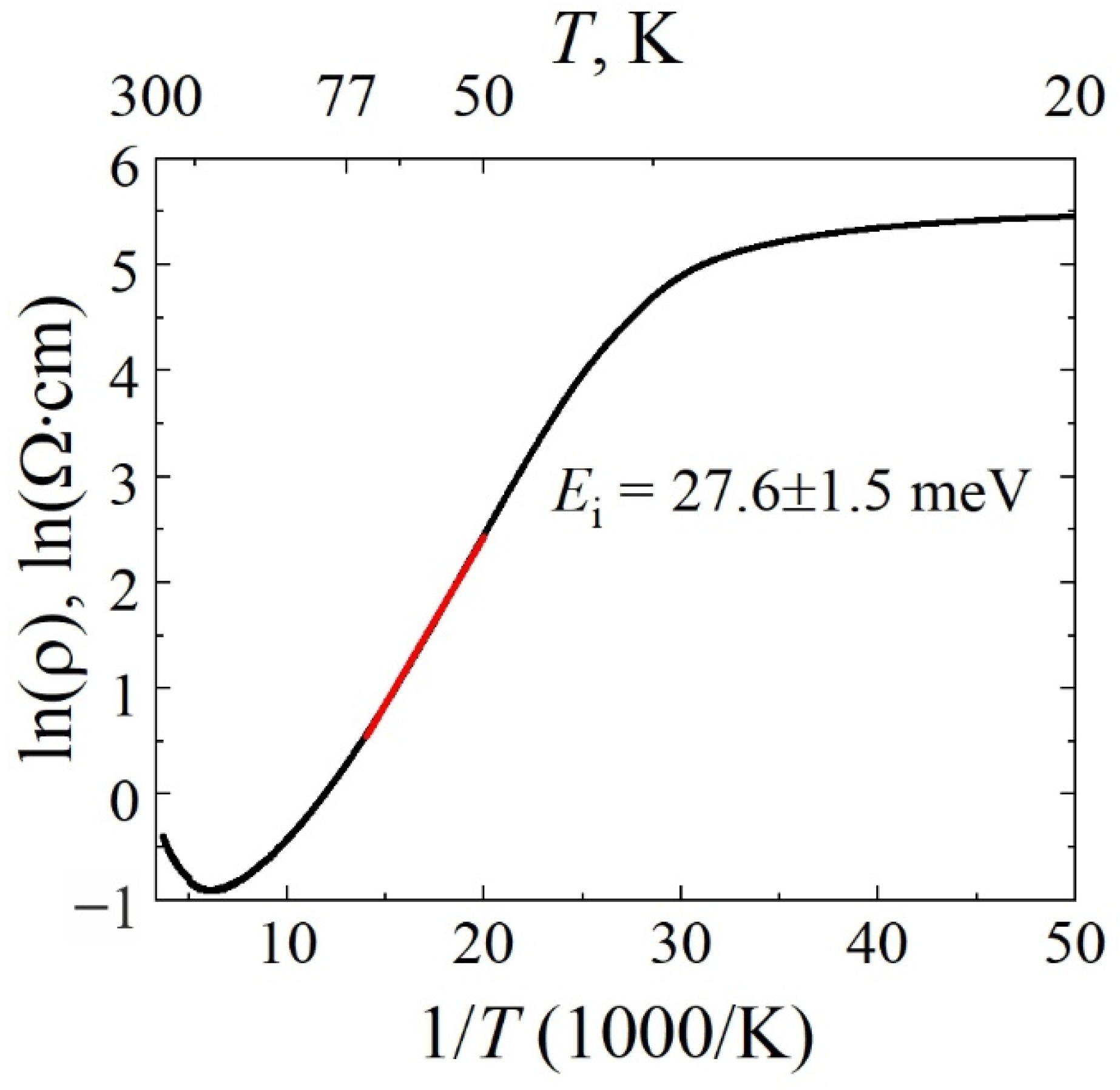
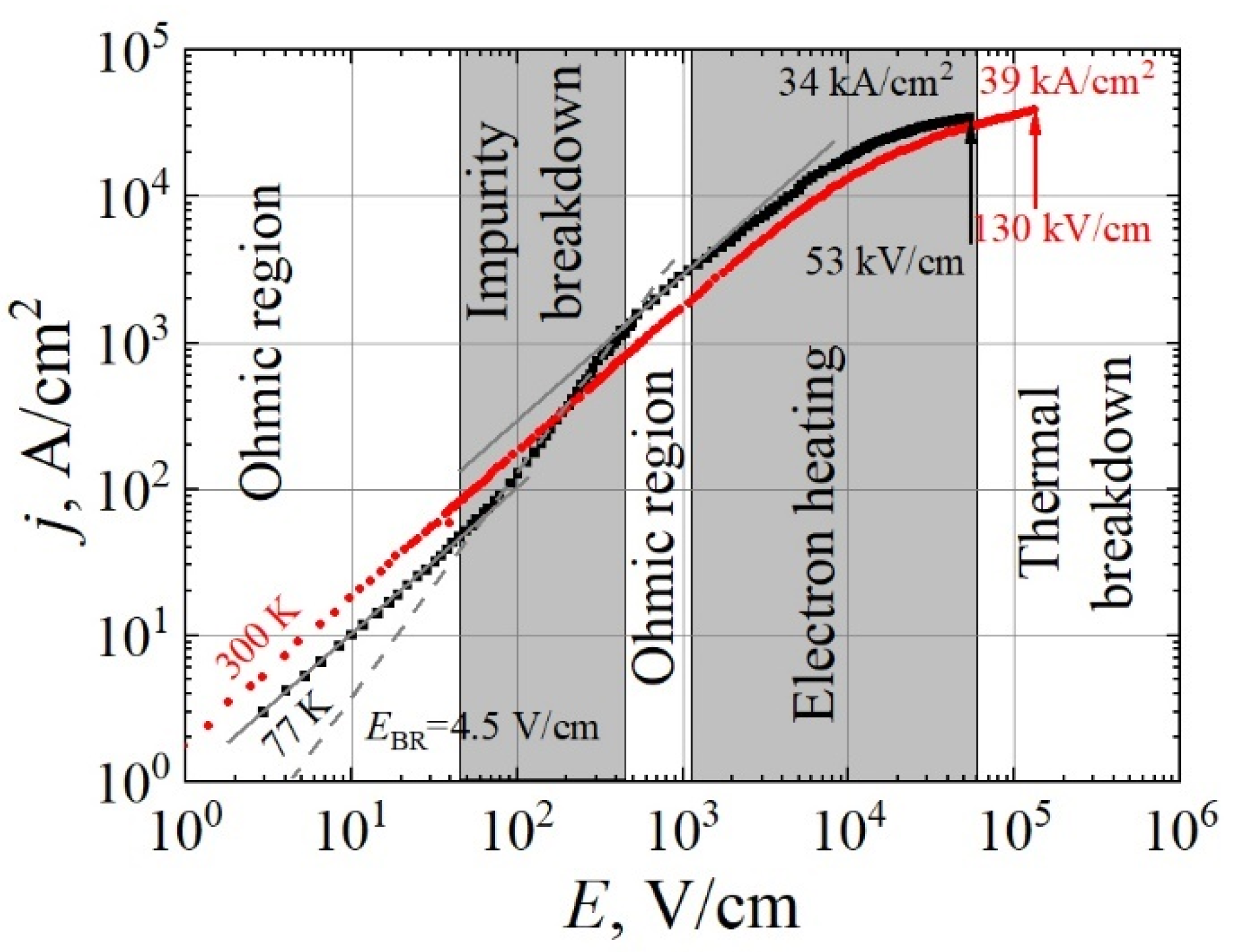
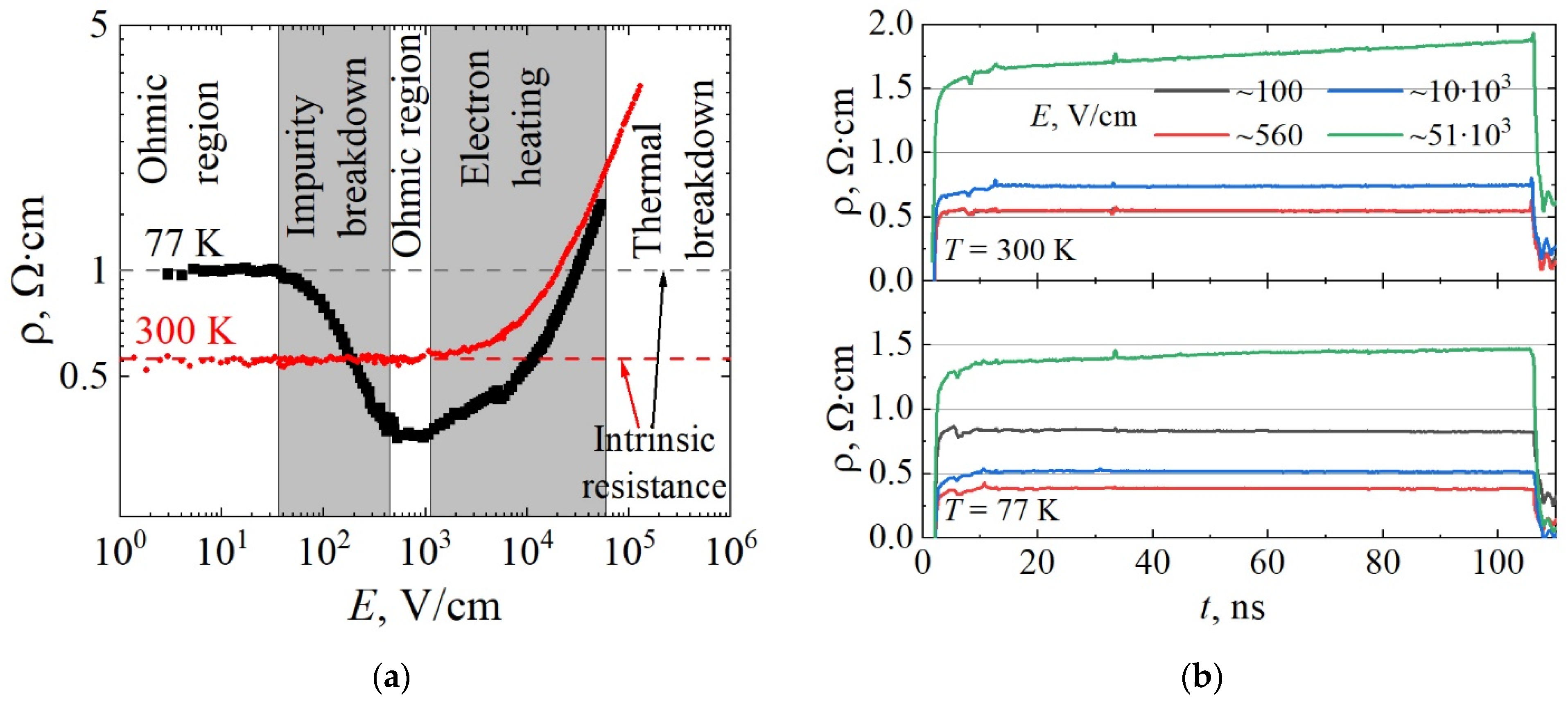
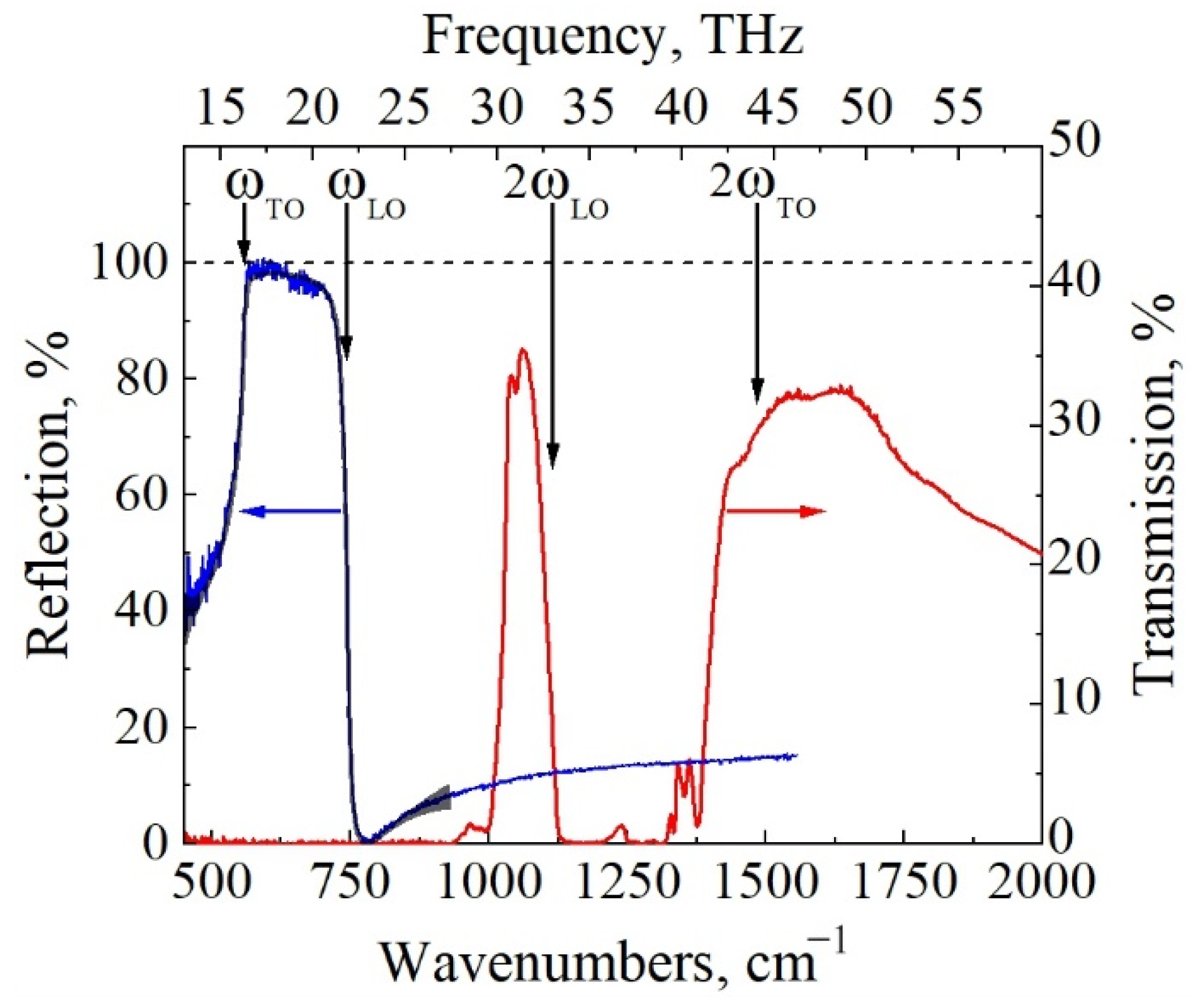
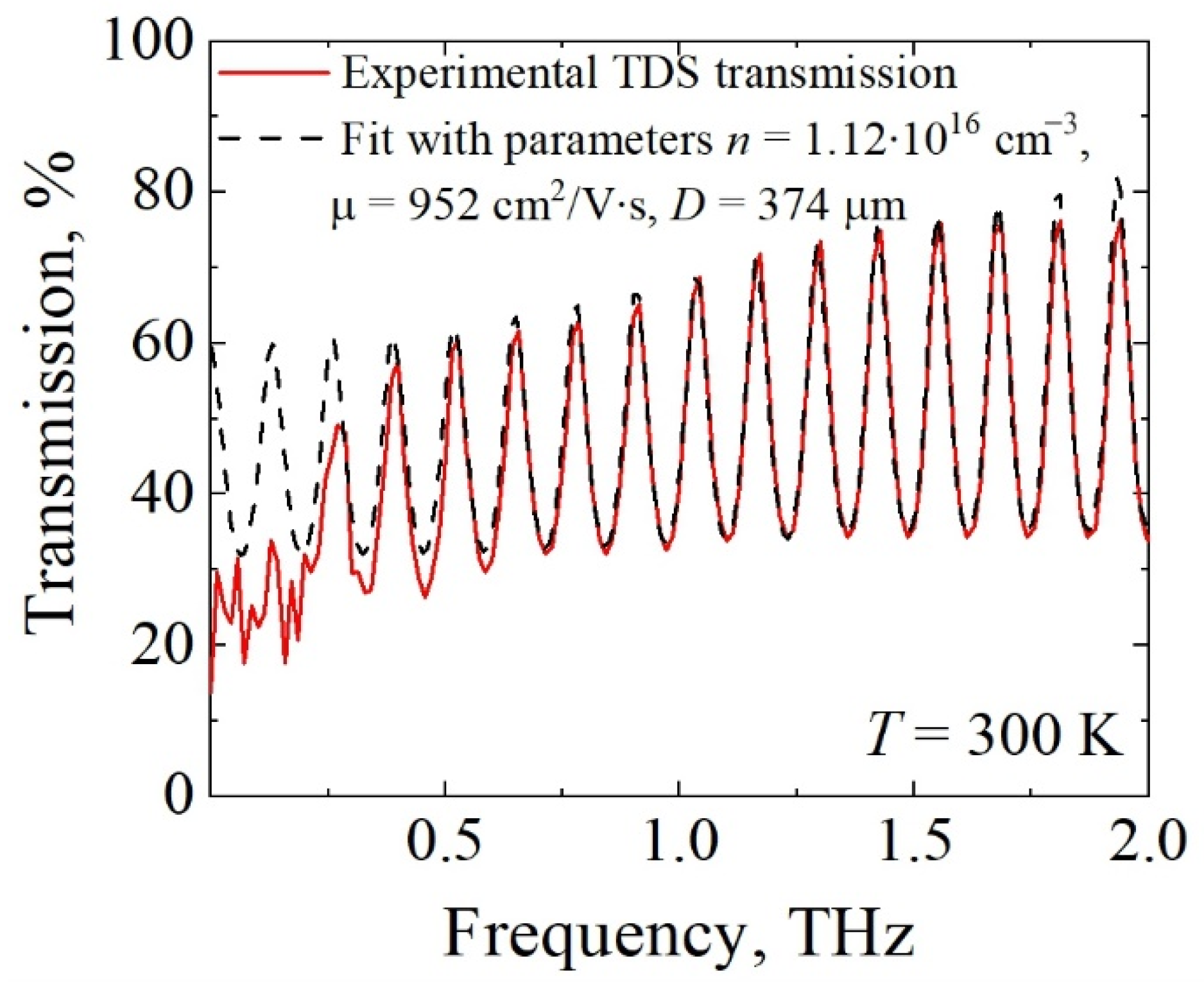
| Contacts | Rc norm, Ω·mm | LT, μm | Rsheet, Ω/□ |
|---|---|---|---|
| CTLM | 3.24 ± 0.03 | 5.14 ± 0.12 | 630 ± 13 |
| N-TLM | 2.98 ± 0.08 | 5.09 ± 0.15 | 586 ± 7 |
| W-TLM | 3.49 | 5.75 | 606 |
| Van der Pauw | ||||
| T, K | n, × 1016 cm−3 | µ, cm2/V·s | ρ, Ω·cm | Thickness d, μm |
| 300 | 1.06 ± 0.02 | 1021 ± 6 | 0.56 | |
| 77 | 0.21 ± 0.01 | 2652 ± 33 | 1.09 | |
| IR reflection | ||||
| 300 | 1.19 | 952 | 0.55 | 375 |
| THz TDS transmission | ||||
| 300 | 1.12 | 952 | 0.59 | 374 |
Publisher’s Note: MDPI stays neutral with regard to jurisdictional claims in published maps and institutional affiliations. |
© 2022 by the authors. Licensee MDPI, Basel, Switzerland. This article is an open access article distributed under the terms and conditions of the Creative Commons Attribution (CC BY) license (https://creativecommons.org/licenses/by/4.0/).
Share and Cite
Balagula, R.M.; Subačius, L.; Jorudas, J.; Janonis, V.; Prystawko, P.; Grabowski, M.; Kašalynas, I. High-Frequency and High-Power Performance of n-Type GaN Epilayers with Low Electron Density Grown on Native Substrate. Materials 2022, 15, 2066. https://doi.org/10.3390/ma15062066
Balagula RM, Subačius L, Jorudas J, Janonis V, Prystawko P, Grabowski M, Kašalynas I. High-Frequency and High-Power Performance of n-Type GaN Epilayers with Low Electron Density Grown on Native Substrate. Materials. 2022; 15(6):2066. https://doi.org/10.3390/ma15062066
Chicago/Turabian StyleBalagula, Roman M., Liudvikas Subačius, Justinas Jorudas, Vytautas Janonis, Pawel Prystawko, Mikolaj Grabowski, and Irmantas Kašalynas. 2022. "High-Frequency and High-Power Performance of n-Type GaN Epilayers with Low Electron Density Grown on Native Substrate" Materials 15, no. 6: 2066. https://doi.org/10.3390/ma15062066
APA StyleBalagula, R. M., Subačius, L., Jorudas, J., Janonis, V., Prystawko, P., Grabowski, M., & Kašalynas, I. (2022). High-Frequency and High-Power Performance of n-Type GaN Epilayers with Low Electron Density Grown on Native Substrate. Materials, 15(6), 2066. https://doi.org/10.3390/ma15062066








